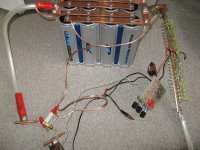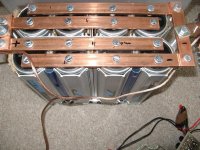I looked at McMaster again ,a few weeks ago, but wow, that's a lot of money for not a lot of material. Still, after ten or more hours of searching, I haven't found any better deals for small quantities.
A good way to cut any sheet metal (softer than steel, and under about .04") is with a paper cutter... The guillotine type, not the rotary stuff. I've been cutting sheet brass, bronze, silver, gold, copper, aluminum etc. with one I bought from Staples or Office Depot for about $20, for more than 20 years. A lot neater and easier than I can cut with shears for anything over a couple inches wide/long.
Rhoon: Glad you got it working!.
The Molybdenum rod came in today... Well, yesterday, since it is now after midnight. Made up a couple of 'pencils' of it like I did with the elkonite and spent an hour or two experimenting
Yeah, I like it. Another step up in durability like the elkonite was from plain copper. Better quality welds on copper, Great on steel to steel and copper or steel to titanium.
Just in time for building the new battery packs: Will finish running the first 55 cells through the CBAII tomorrow.
LOUSY on nickel though. The moly doesn't stick to the nickel, but the nickel sure sticks to the moly. Even at 12V and single pulse it is unusable on nickel.
But for tabbing with copper, I don't think we are going to find anything better.
I'm thinking of offering some copper covered molybdenum 'pencils' or complete electrode-handpieces for sale at not too outrageous prices. Let me know if you might be interested.
Oh.... I just remembered where I got nickel sheet back in the old days when I was making patterned Damascus for knife blades:.... Let me check.....
Yeah, MUCH Cheaper than McMaster:
http://www.admiralsteel.com/shop/201.html
and you can get smaller pieces if you don't need as much:
http://www.admiralsteel.com/pdf/bladesteel.pdf
About half way down the PDF page, on the left side: 201 nickel.
$4.72 for 12"X6" of .005
$9.62 for 12"X6" of .01



